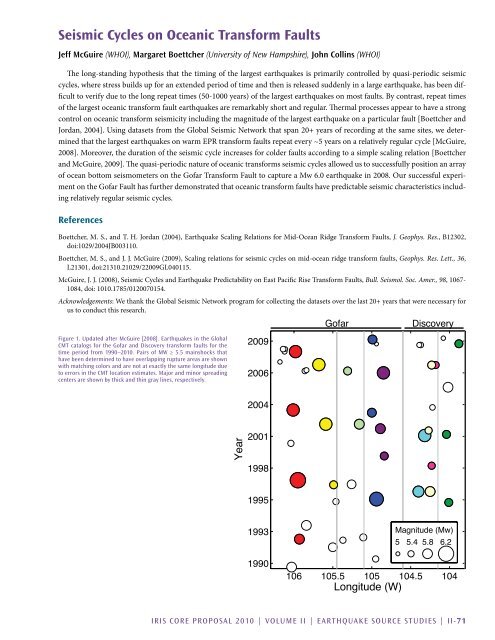Accomplishments - IRIS
Accomplishments - IRIS
Accomplishments - IRIS
Create successful ePaper yourself
Turn your PDF publications into a flip-book with our unique Google optimized e-Paper software.
Seismic Cycles on Oceanic Transform Faults<br />
Jeff McGuire (WHOI), Margaret Boettcher (University of New Hampshire), John Collins (WHOI)<br />
The long-standing hypothesis that the timing of the largest earthquakes is primarily controlled by quasi-periodic seismic<br />
cycles, where stress builds up for an extended period of time and then is released suddenly in a large earthquake, has been difficult<br />
to verify due to the long repeat times (50-1000 years) of the largest earthquakes on most faults. By contrast, repeat times<br />
of the largest oceanic transform fault earthquakes are remarkably short and regular. Thermal processes appear to have a strong<br />
control on oceanic transform seismicity including the magnitude of the largest earthquake on a particular fault [Boettcher and<br />
Jordan, 2004]. Using datasets from the Global Seismic Network that span 20+ years of recording at the same sites, we determined<br />
that the largest earthquakes on warm EPR transform faults repeat every ~5 years on a relatively regular cycle [McGuire,<br />
2008]. Moreover, the duration of the seismic cycle increases for colder faults according to a simple scaling relation [Boettcher<br />
and McGuire, 2009]. The quasi-periodic nature of oceanic transforms seismic cycles allowed us to successfully position an array<br />
of ocean bottom seismometers on the Gofar Transform Fault to capture a Mw 6.0 earthquake in 2008. Our successful experiment<br />
on the Gofar Fault has further demonstrated that oceanic transform faults have predictable seismic characteristics including<br />
relatively regular seismic cycles.<br />
References<br />
Boettcher, M. S., and T. H. Jordan (2004), Earthquake Scaling Relations for Mid-Ocean Ridge Transform Faults, J. Geophys. Res., B12302,<br />
doi:1029/2004JB003110.<br />
Boettcher, M. S., and J. J. McGuire (2009), Scaling relations for seismic cycles on mid-ocean ridge transform faults, Geophys. Res. Lett., 36,<br />
L21301, doi:21310.21029/22009GL040115.<br />
McGuire, J. J. (2008), Seismic Cycles and Earthquake Predictability on East Pacific Rise Transform Faults, Bull. Seismol. Soc. Amer., 98, 1067-<br />
1084, doi: 1010.1785/0120070154.<br />
Acknowledgements: We thank the Global Seismic Network program for collecting the datasets over the last 20+ years that were necessary for<br />
us to conduct this research.<br />
Gofar<br />
Discovery<br />
Figure 1. Updated after McGuire [2008]. Earthquakes in the Global<br />
CMT catalogs for the Gofar and Discovery transform faults for the<br />
time period from 1990–2010. Pairs of MW ≥ 5.5 mainshocks that<br />
have been determined to have overlapping rupture areas are shown<br />
with matching colors and are not at exactly the same longitude due<br />
to errors in the CMT location estimates. Major and minor spreading<br />
centers are shown by thick and thin gray lines, respectively.<br />
2009<br />
2006<br />
2004<br />
Year<br />
2001<br />
1998<br />
1995<br />
1993<br />
1990<br />
Magnitude (Mw)<br />
5 5.4 5.8 6.2<br />
106 105.5 105 104.5 104<br />
Longitude (W)<br />
<strong>IRIS</strong> Core Proposal 2010 | Volume II | Earthquake Source Studies | II-71

















